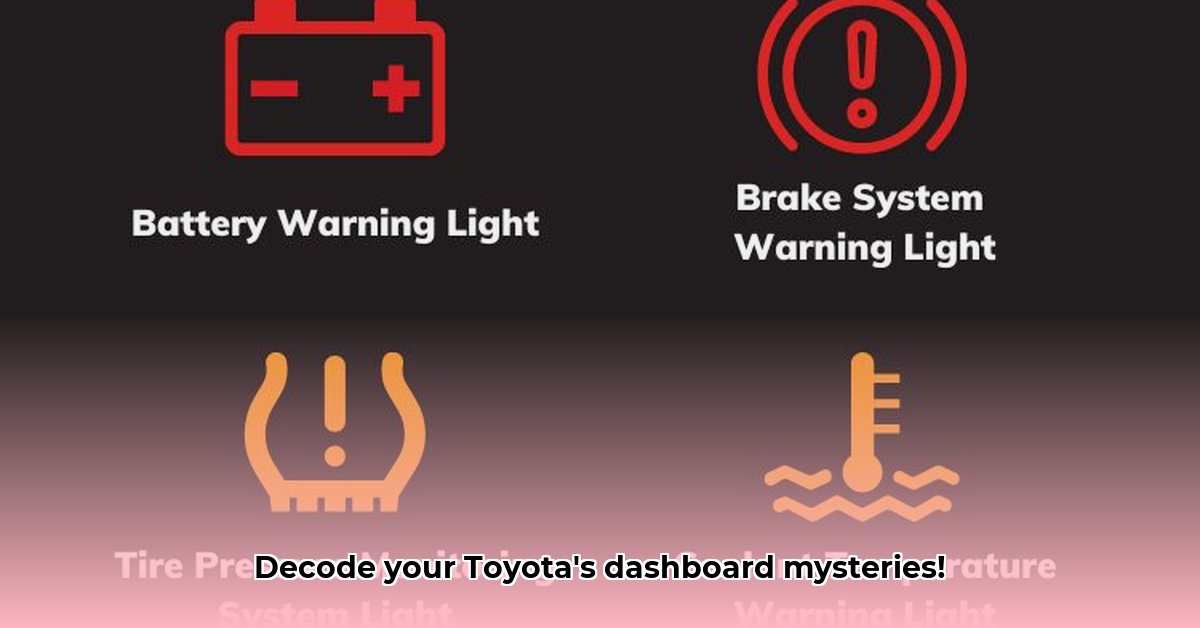
Understanding your Toyota's dashboard warning lights is crucial for safe driving and maintaining your vehicle's health. This guide provides a clear explanation of common indicators, their severity, and recommended actions. Ignoring these lights can lead to costly repairs or even accidents, so paying attention is essential.
Severity Levels: Red Means Stop! Yellow Means "Check It Out Soon"
Toyota uses two primary colors to indicate the urgency of a problem: red and yellow. Red lights signal immediate danger, requiring you to stop driving and seek assistance. Yellow lights signify that an issue needs attention but don't necessitate an immediate stop. Think of red as "Stop and seek help NOW," and yellow as "Check this out at your earliest convenience."
Decoding the Dashboard: Common Toyota Warning Lights Explained
This table explains some common Toyota dashboard warning lights. Remember, your owner's manual contains the most precise information for your specific model and year.
| Indicator | Description | Severity | Recommended Action |
|---|---|---|---|
| Check Engine Light (CEL) | Indicates a problem with the engine's emission control system. This could range from a minor issue like a loose gas cap to a serious engine malfunction. | Yellow/Red | Have a mechanic diagnose the problem promptly. Continuing to drive with a persistent CEL may cause further damage. |
| Low Fuel Warning Light | Your fuel tank is low. | Yellow | Refuel your vehicle as soon as possible. Running out of gas can lead to dangerous roadside situations. |
| Low Oil Pressure Warning Light | Your engine isn't receiving sufficient oil lubrication—a critical problem. | Red | Stop driving immediately! Engine damage can occur rapidly without proper lubrication. |
| Brake System Warning Light | Indicates a problem within the braking system. This might include low brake fluid, worn brake pads, or other brake-related issues. | Red | Do NOT drive. Have your braking system thoroughly inspected by a qualified mechanic immediately. |
| Battery Warning Light | Indicates a problem with the car's charging system or the battery itself. | Yellow/Red | Have your charging system and battery checked. A malfunctioning battery can leave you stranded. |
| Tire Pressure Monitoring System (TPMS) | One or more tires have low air pressure. | Yellow | Check tire pressure using a gauge. Inflate tires to the recommended pressure (found in your owner's manual). |
| Airbag Warning Light (SRS) | Indicates a malfunction in the airbag system. | Red | Get this fixed immediately. Your airbags may not deploy in an accident. |
| VSC/TRAC Off Light (Vehicle Stability Control/Traction Control) | Your vehicle stability control or traction control system is off. This significantly reduces your car's ability to handle slippery conditions. | Yellow | Ensure the system is turned on unless driving in extremely challenging conditions where it's advisable to disable it. |
Hybrid System Indicators (For Hybrid Toyotas Only)
Hybrid Toyota models have additional warning lights related to their hybrid system. These lights indicate the system's status or potential problems. Consult your owner's manual for precise details on these indicators as they vary depending on your model year. Ignoring these lights could negatively affect fuel efficiency or cause the hybrid system to malfunction, resulting in expensive repairs.
DIY Troubleshooting: Basic Checks You Can Perform
While many issues require professional attention, some simple checks can be performed at home:
- Check Fluids: Regularly check engine oil, coolant, brake fluid, and power steering fluid (if equipped). Low levels can trigger warning lights. Refer to your owner's manual for proper checking procedures.
- Tire Pressure: Use a reliable gauge to check tire pressure of all four tires. Inflate to the manufacturer's recommended pressure (found in your owner's manual).
- Battery Terminals: If the battery light is on, inspect the battery terminals for corrosion. Clean them with a wire brush if necessary.
Important Note: If a red warning light appears, especially those related to braking or engine oil pressure, stop driving immediately! Your safety is paramount.
Preventative Maintenance: Proactive Care
Regular maintenance minimizes the likelihood of warning lights appearing. Adhere to the recommended maintenance schedule in your owner's manual. Preventative maintenance such as regular oil changes, fluid checks, and tire rotations are crucial for a healthy and safe vehicle.
The Final Word: Consult Your Owner's Manual
This guide offers general information; always refer to your owner's manual for precise details specific to your Toyota's make, model, and year. The owner's manual provides the ultimate resource for understanding your vehicle's warning system.
Key Takeaways:
- Understanding your Toyota's warning lights is essential for safe driving and proactive vehicle maintenance.
- Red lights demand immediate attention, yellow lights require prompt action.
- Your owner's manual is your primary resource for deciphering warning light meanings and addressing potential problems.
- Preventative maintenance is crucial in preventing issues and extending your vehicle's lifespan.